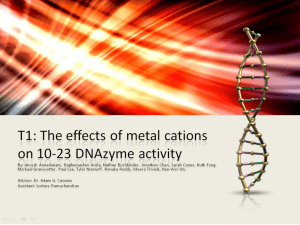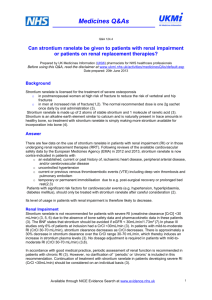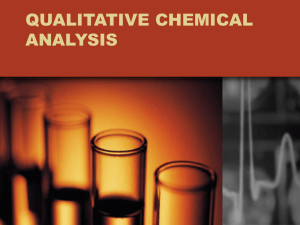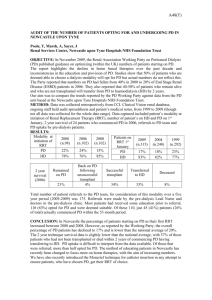UKMi Q&A xx - NHS Evidence Search
advertisement
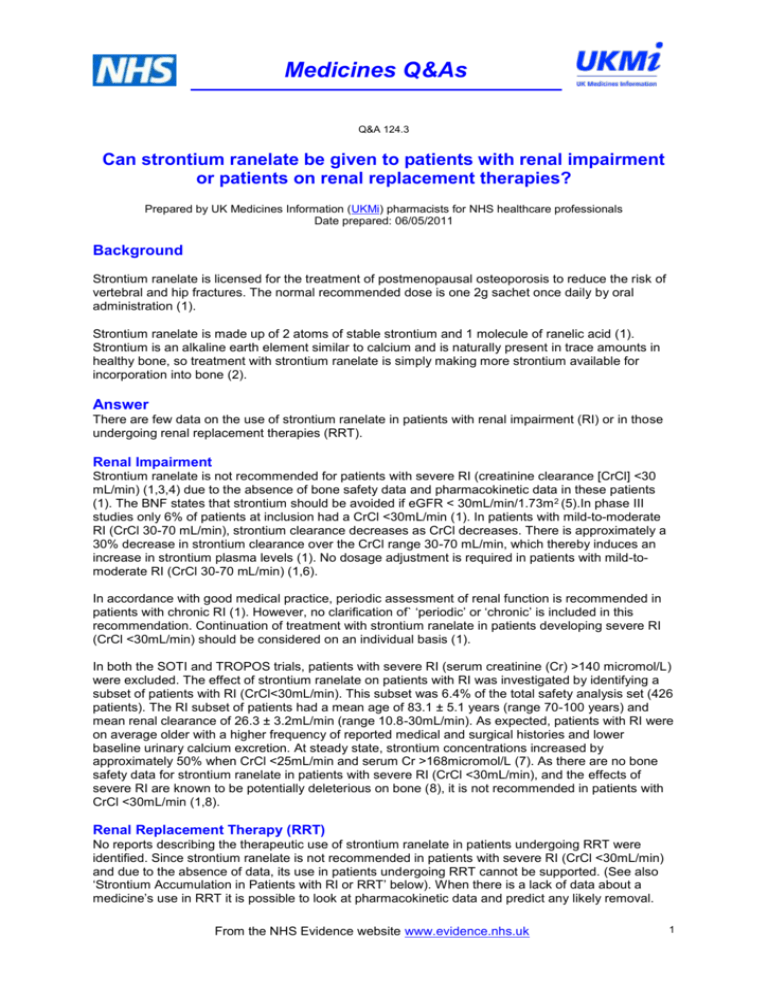
Medicines Q&As Q&A 124.3 Can strontium ranelate be given to patients with renal impairment or patients on renal replacement therapies? Prepared by UK Medicines Information (UKMi) pharmacists for NHS healthcare professionals Date prepared: 06/05/2011 Background Strontium ranelate is licensed for the treatment of postmenopausal osteoporosis to reduce the risk of vertebral and hip fractures. The normal recommended dose is one 2g sachet once daily by oral administration (1). Strontium ranelate is made up of 2 atoms of stable strontium and 1 molecule of ranelic acid (1). Strontium is an alkaline earth element similar to calcium and is naturally present in trace amounts in healthy bone, so treatment with strontium ranelate is simply making more strontium available for incorporation into bone (2). Answer There are few data on the use of strontium ranelate in patients with renal impairment (RI) or in those undergoing renal replacement therapies (RRT). Renal Impairment Strontium ranelate is not recommended for patients with severe RI (creatinine clearance [CrCl] <30 mL/min) (1,3,4) due to the absence of bone safety data and pharmacokinetic data in these patients (1). The BNF states that strontium should be avoided if eGFR < 30mL/min/1.73m 2 (5).In phase III studies only 6% of patients at inclusion had a CrCl <30mL/min (1). In patients with mild-to-moderate RI (CrCl 30-70 mL/min), strontium clearance decreases as CrCl decreases. There is approximately a 30% decrease in strontium clearance over the CrCl range 30-70 mL/min, which thereby induces an increase in strontium plasma levels (1). No dosage adjustment is required in patients with mild-tomoderate RI (CrCl 30-70 mL/min) (1,6). In accordance with good medical practice, periodic assessment of renal function is recommended in patients with chronic RI (1). However, no clarification of` ‘periodic’ or ‘chronic’ is included in this recommendation. Continuation of treatment with strontium ranelate in patients developing severe RI (CrCl <30mL/min) should be considered on an individual basis (1). In both the SOTI and TROPOS trials, patients with severe RI (serum creatinine (Cr) >140 micromol/L) were excluded. The effect of strontium ranelate on patients with RI was investigated by identifying a subset of patients with RI (CrCl<30mL/min). This subset was 6.4% of the total safety analysis set (426 patients). The RI subset of patients had a mean age of 83.1 ± 5.1 years (range 70-100 years) and mean renal clearance of 26.3 ± 3.2mL/min (range 10.8-30mL/min). As expected, patients with RI were on average older with a higher frequency of reported medical and surgical histories and lower baseline urinary calcium excretion. At steady state, strontium concentrations increased by approximately 50% when CrCl <25mL/min and serum Cr >168micromol/L (7). As there are no bone safety data for strontium ranelate in patients with severe RI (CrCl <30mL/min), and the effects of severe RI are known to be potentially deleterious on bone (8), it is not recommended in patients with CrCl <30mL/min (1,8). Renal Replacement Therapy (RRT) No reports describing the therapeutic use of strontium ranelate in patients undergoing RRT were identified. Since strontium ranelate is not recommended in patients with severe RI (CrCl <30mL/min) and due to the absence of data, its use in patients undergoing RRT cannot be supported. (See also ‘Strontium Accumulation in Patients with RI or RRT’ below). When there is a lack of data about a medicine’s use in RRT it is possible to look at pharmacokinetic data and predict any likely removal. From the NHS Evidence website www.evidence.nhs.uk 1 Medicines Q&As For further information please see Q&A 168.4 – What factors need to be considered when dosing patients on RRT? (9) Strontium Accumulation in Patients with RI or RRT In patients with chronic RI or in patients undergoing RRT who are not receiving strontium therapy, there are some data to suggest that accumulation of naturally occurring strontium may occur (10,11,12,13,14). Moreover there is some concern that strontium accumulation may have a detrimental effect on bones including osteomalacia (14). This gives grounds for concern about the possible safety of strontium ranelate in these groups of patients. The clinical consequences of strontium accumulation in these populations require clarification. Strontium may accumulate in patients with chronic renal failure because of: impaired renal function, contamination of phosphate binders, the use of strontium-containing parenteral and dialysis fluids (10). An epidemiological survey of 75 patients with stable RI, 834 haemodialysis (HD) patients and 24 control subjects, found that serum strontium levels are higher in patients with RI and in HD patients when compared to control subjects (10). Another small study compared 32 patients on HD with 19 control subjects found that blood plasma strontium concentrations were higher in the HD patients (13). In HD patients, whilst individual measurements suggest that there is an exchange of strontium between plasma and dialysate, there was no statistically significant mean change in strontium plasma levels during the dialysis session (13). The changes in plasma strontium levels during dialysis appear to correlate well with the difference between dialysis fluid and plasma concentration at the beginning of the session (13). Similarly serum strontium levels were statistically significantly higher in a small study of 24 continuous ambulatory peritoneal dialysis (CAPD) and 14 chronic renal failure (CRF) patients when compared with 52 healthy controls. It was found that CAPD was not able to restore strontium plasma levels to normal (12). Another study monitored serum strontium levels in 1031 patients undergoing RRT (including standard acetate dialysis, bicarbonate dialysis, haemofiltration and CAPD). The patients were all receiving various aluminium-containing phosphate-binders. It found that serum strontium levels were significantly higher in those receiving RRT than in control subjects (15). This suggests that in dialysis patients, strontium overload in the bone may be possible (15). However, this study should be interpreted with caution, since no detail is provided about the control arm of the study. A study of bone biopsies in 100 HD patients and 10 controls showed that HD patients had significantly higher bone strontium/calcium ratios compared with controls. Additionally, within the dialysis population, both bone strontium levels and strontium/calcium ratios were significantly higher in patients with osteomalacia (14). Conversely, another small study found that the bone strontium content in 56 patients with chronic HD was not significantly different from control values of patients with normal renal function (11). However, the HD patients with osteomalacia had slightly, but significantly increased levels of bone strontium, although the authors state that they found no correlation between osteoid accumulation and bone strontium content. Further study is needed to define the relationship between mineralisation defects in renal patients and strontium levels (11) and to determine whether strontium plays either a primary, secondary or contributive role in the development of renal osteodystrophy (14). Therefore the evidence for a possible link between high levels of bone strontium in dialysis patients with RI and the development of osteomalacia is inconclusive. During the SOTI (16) and TROPOS (17) trials no evidence of osteomalacia was detected in any bone biopsies (7). However, neither did these studies provide bone safety data in RI as patients with severe RI (serum Cr >140micromol/L) were excluded (7). It should also be noted that there were high losses to follow-up in the SOTI and TROPOS trials (16, 17). Adverse effects The following information was discussed by the European Medicines Agency prior to license approval of strontium ranelate. Discrete but consistent increases in reporting of nervous system disorders in From the NHS Evidence website www.evidence.nhs.uk 2 Medicines Q&As patients on strontium ranelate were observed. These included disturbances in consciousness, amnesia, memory loss, seizures and encephalopathies. Overall, between-group differences for these adverse effects appeared enhanced in patients ≥ 80 years and in patients with CrCl <30mL/min (8). However the manufacturer states that there were no differences in the nature of adverse events between treatment groups regardless of whether patients were aged below or above 80 at inclusion (1). In phase III studies of strontium ranelate, over 5 years, nervous system disorders were reported with higher frequency in patients treated with strontium ranelate compared with placebo: disturbances in consciousness (2.6% vs. 2.1%), memory loss (2.5% vs. 2.0%) and seizures (0.4% vs. 0.1%) (1). In phase III studies, the annual incidence of venous thromboembolism (VTE) observed over 5 years was approximately 0.7%, with a relative risk of 1.4 (95% CI = [1.0 to 2.0]) in strontium ranelate treated patients as compared to placebo (1). Strontium ranelate should be used with caution in patients at increased risk of VTE (1). Cases of severe hypersensitivity syndromes, including DRESS (drug rash with eosinophilia and systemic symptoms), sometimes fatal, have been reported with strontium ranelate (1). This has included systemic involvement such as interstitial nephropathy (1). Summary Strontium ranelate is not recommended for use in patients with severe RI (CrCl <30 mL/min) or in patients undergoing RRT. This is due to: an absence of bone safety data and pharmacokinetic data in these patients, concerns that natural strontium may accumulate in patients with RI and RRT, an inconclusive link between strontium accumulation and bone disease, an increased incidence of reported nervous system disorders in patients with severe RI. Strontium ranelate can be given to patients with mild-to-moderate renal impairment (CrCl 3070 mL/min) without a need for dosage adjustment. Periodic assessment of renal function is recommended in patients with chronic RI, but the frequency of monitoring is not stated. Continuation of treatment with strontium ranelate in patients developing severe RI (CrCl <30mL/min) should be considered on an individual basis. In clinical trials, steady state strontium concentrations were increased by approximately 50% when CrCl <25mL/min. There is some evidence to suggest that naturally occurring strontium may accumulate in patients with RI and in those undergoing RRT, but the clinical consequences of this are uncertain. In all patients with RI or receiving RRT, the decision to use strontium ranelate remains a clinical decision, balancing the potential benefits of therapy against the potential risks. Limitations There are very few data available for patients with RI and no data for patients undergoing RRT receiving strontium ranelate. The information that is available is largely from small studies with poor design. Further investigation is needed to confirm the safety and efficacy of strontium ranelate in patients with CRF or undergoing RRT. Additional study of the clinical consequences of accumulation of strontium in patients with RI or on RRT, and the possible link between high strontium levels and bone disease is required. From the NHS Evidence website www.evidence.nhs.uk 3 Medicines Q&As Disclaimer Medicines Q&As are intended for healthcare professionals and reflect UK practice. Each Q&A relates only to the clinical scenario described. Q&As are believed to accurately reflect the medical literature at the time of writing. The authors of Medicines Q&As are not responsible for the content of external websites and links are made available solely to indicate their potential usefulness to users of NeLM. You must use your judgement to determine the accuracy and relevance of the information they contain. See www.ukmi.nhs.uk/activities/medicinesQAs/default.asp for full disclaimer. References 1) 2) 3) 4) 5) 6) 7) 8) 9) 10) 11) 12) 13) 14) 15) 16) Summary of product characteristics for Protelos 2g granules for oral suspension. Servier Laboratories Limited. Date of revision of text: February 2011. Accessed online via: http://emc.medicines.org.uk on 06/05/11. Fogelman I, Blake GM. Strontium ranelate for the treatment of osteoporosis. British Medical Journal 2005; 330: 1400-1401. National Institute for Health and Clinical Excellence. NICE technology appraisal guidance 160 (amended). Alendronate, etidronate, risedronate, raloxifene and strontium ranelate for the primary prevention of osteoporotic fragility fractures in postmenopausal women (amended). Issue Date: October 2008 (amended January 2010 and January 2011). Accessed online via www.nice.nhs.uk on 10/05/11. National Institute for Health and Clinical Excellence. NICE technology appraisal guidance 161 (amended). Alendronate, etidronate, risedronate, raloxifene, strontium ranelate and teriparatide for the secondary prevention of osteoporotic fragility fractures in postmenopausal women (amended). Issue Date: October 2008 (amended January 2010 and January 2011). Accessed online via www.nice.org.uk on 10/05/11. Martin J, Managing Editor. British National Formulary No. 61 March 2011. London: BMJ Group and Pharmaceutical Press. Accessed online via: www.bnf.org 06/05/11. Ashley, C. Currie, A. editors. Renal Drug Handbook 3rd Edition. Oxford, Radcliffe Medical Press Ltd; 2009, p.688. Personal Communication with Therapeutic Information Officer for Servier Laboratories Ltd, 17th May 2011. European Medicines Agency. Protelos. European Public Assessment Report 2005. Scientific Discussion. Accessed via: http://www.ema.europa.eu/docs/en_GB/document_library/EPAR__Scientific_Discussion/human/000560/WC500045522.pdf on 10/06/11. Kuczynska J. Q&A 168.4 - What factors need to be considered when dosing patients on renal replacement therapies? South West Medicines Information & Training. Prepared January 2011. Accessed via www.nelm.nhs.uk on 10/06/11. Schrooten I, Elseviers MM, Lamberts LV et al. Increased serum strontium levels in dialysis patients: An epidemiological survey. Kidney International 1999; 56: 1886-1892. Cohen-Solal ME, Augry F, Mauras Y et al. Fluoride and strontium accumulation in bone does not correlate with osteoid tissue in dialysis patients. Nephrology Dialysis Transplantation 2002; 17: 449-454. Apostolidis N, Paradellis T, Karydas A et al. Calcium and strontium metabolic studies in patients on CAPD. Peritoneal Dialysis International 1998; 18: 410-414. Mauras Y, Ang KS, Simon P et al. Increase in blood plasma levels of boron and strontium in hemodialyzed patients. Clinica Chimica Acta 1986; 156: 315-320. D’Haese PC, Schrooten I, Goodman WG et al. Increased bone strontium levels in hemodialysis patients with osteomalacia. Kidney International 2000; 57: 1107-1114. Canavese C, Pacitti A, Salomone M et al. Strontium overload in uremic patients on regular dialytic treatment. Trans Am Soc Artif Intern Organs 1986; 32: 120-122. Meunier PJ, Roux C, Seeman E et al. The effects of strontium ranelate on the risk of vertebral fracture in women with postmenopausal osteoporosis. (The Spinal Osteoporosis Therapeutic Intervention [SOTI] study). New England Journal of Medicine 2004; 350 (5): 459-468. From the NHS Evidence website www.evidence.nhs.uk 4 Medicines Q&As 17) Reginster JY, Seeman E, De Vernejoul MC et al. Strontium ranelate reduces the risk of nonvertebral fractures in postmenopausal women with osteoporosis: treatment of peripheral osteoporosis (TROPOS) study. J Clin Endocrinol Metab 2005; 90; 2816-2822. Quality Assurance Prepared by Michèle Skipp, South West Medicines Information, Bristol Date prepared 6th May 2011 Checked by Julia Kuczynska, South West Medicines Information, Bristol Date of check 17th June 2011 Search strategy Embase [*STRONTIUM RANELATE/ OR (strontium AND ranelate).ti,ab] AND [exp *KIDNEY FAILURE/ OR exp *RENAL REPLACEMENT THERAPY/] Limit to: Humans. Medline [*STRONTIUM ISOTOPES/ OR *STRONTIUM/ OR (strontium AND ranelate).ti,ab] AND [exp *RENAL REPLACEMENT THERAPY/ OR exp *RENAL INSUFFICIENCY/] Limit to: Humans. In-house database / resources Keyword – Strontium. In-house renal files and texts. DRUGDEX Drug Evaluations. Accessed via www.thomsonhc.com on 17/06/11. Manufacturer (Servier Laboratories Ltd. Personal Communication. Letter dated 17/05/11). Internet Search (National Library for Health; Prodigy; Cochrane Library; National Electronic Library for Medicine; NICE; SIGN). Clinical Expert: Specialist Renal Pharmacist, Royal Devon & Exeter Hospital. From the NHS Evidence website www.evidence.nhs.uk 5
